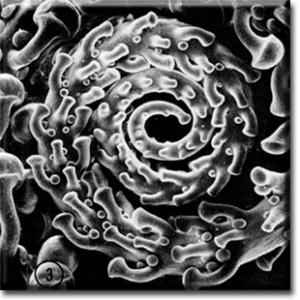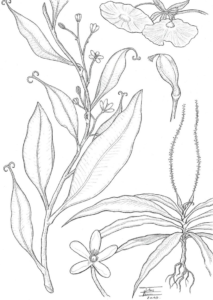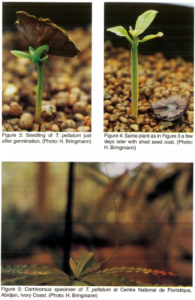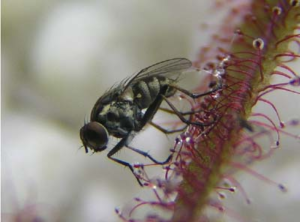Triphyophyllum /ˌtrɪfioʊˈfɪləm/ is a monotypic plant genus, containing the single species Triphyophyllum peltatum of the family Dioncophyllaceae. It is native to tropical western Africa, in Ivory Coast, Sierra Leone and Liberia, growing in tropical forests.

It is a liana, with a three-stage lifecycle, each with a different shaped leaf, as indicated by its Greek name. In the first stage, T. peltatum forms a rosette of simple lanceolate leaves with wavey margins, and looks nondescript. However, it then additionally develops long, slender, glandular leaves mostly in February and March, resembling those of the related Drosophyllum, which capture insects; one to three of these leaves in each rosette. [1] The plant then enters its adult liana form, with short non-carnivorous leaves bearing a pair of grappling hooks [2] at the tip on a long twining stem which can become 165 feet (50 meters) in length and four inches (10 cm) thick.[3]

T. peltatum is the largest of all confirmed carnivorous plants in the world, but its carnivorous nature did not become known until 1979, some 51 years after the plant’s discovery.[4] Perhaps even more remarkable than its three very different leaf types are it fruit and seed. The seeds are about 3 inches (7.5 cm) in diameter, bright red in color and shaped like a galaxy or discus with a peltate stalk emerging from the fruit. Most of the seed’s development occurs outside the fruit.[5] This remarkable fruit and seed develop from an orange flower with five incurved petals. [6]

T. peltatum is currently cultivated in only three botanical gardens: Abidjan, Bonn, and Würzburg. It is exceedingly rare in private collections.
-

Triphyophyllumcompounds; top left: R = -H: Habropetalin A; R = -OH: Dioncophyllin A.; bottom left: Dioncophyllin; bottom right: Dioncophyllin C.

References
- Bringmann, G., H. Rischer, J. Schlauer, K. Wolf, A. Kreiner, M. Duschek & L.A. Assi 2002. “The Tropical Liana Triphyophyllum peltatum (Dioncophyllaceae): Formation of Carnivorous Organs is only a facultative prerequisite for shoot elongation.” (PDF). (1.30 MiB) Carnivorous Plant Newsletter 31(2): 44–52.
- Bringmann, G., J. Schlauer, K. Wolf, H. Rischer, U. Buschbom, A. Kreiner, F. Thiele, M. Duschek & L.A. Assi 1999. “Cultivation of Triphyophyllum peltatum (Dioncophyllaceae), the part-time carnivorous plant.” (PDF). (1.25 MiB)Carnivorous Plant Newsletter 28(1): 7–13.
- Bringmann, G., M. Wenzel, H.P. Bringmann & J. Schlauer 2001. “Uptake of the amino acid alaninie by digestive leaves: proof of carnivory in the tropical liana Triphyophyllum peltatum (Dioncophyllaceae).” (PDF). (434 KiB)Carnivorous Plant Newsletter 30(1): 15–21.
- Jonathan 1992. “A letter from Sierra Leone.” (PDF). (541 KiB) Carnivorous Plant Newsletter 21(3): 51–53.
- Rice, B. 2007. Carnivorous plants with hybrid trapping strategies. Carnivorous Plant Newsletter 36(1): 23–27.
- Simons, P. 1981. “How Exclusive are Carnivorous Plants?” (PDF). (1.10 MiB) Carnivorous Plant Newsletter 10(3): 65–68, 79–80.
